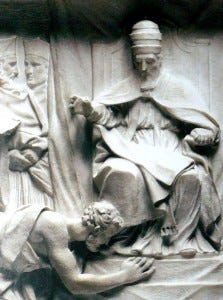Papal Rivalries and the Separation of Church and State - Pt Three
On the early modern separation of the Church into different states. Also, the game-theory of ancient Near-Eastern King/Priest dualities, and Conciliarism as an Ecclesial road not taken.
The popular narrative for European history tells the story of separation between Church and State as a feature of the modern world, connected especially to the Reformation and Wars of Religion. I don’t think this narrative is entirely wrong, but I think it’s incomplete. The theme of papal rivalries we’ve been looking at in Parts One and Two of this series can help shed light on what the old narrative misses. To give away part of the answer up front, I think the multipolar world of medieval Europe created by the Fall of the Western Roman Empire helped lead to a fragmentation of Church power and influence even before and apart from the Reformation. Consequently, this political fragmentation of Europe makes the 15th century conciliarist movement an even more interesting “road not taken” for early modern Christendom.
The Received Historiography
As the old received narrative goes, during the Middle Ages, Church and State often clashed, but the Papacy usually won. Pope Gregory VII made King Henry IV bend the knee at Canossa, and the Imperial Papacy of Innocent III became the standard of reference for papal power and prestige. The Avignon and Renaissance Papacies revealed the dangers of such worldly corruption of spiritual power, but the Magisterium’s edifice was only finally challenged by the Reformation. Subsequently, in its religious folly, Europe tore itself apart for over a century during the Wars of Religion, as different Christian sects tried to violently impose their vision of heaven upon each other. Eventually, exhausted and disillusioned after the English Civil War, the St. Bartholomew’s Day Massacre in France, and the Thirty Years’ War in Germany, Europe’s leaders and intellectuals sought for a new system of political legitimacy, and thus created the Scientific Revolution and Enlightenment.
The old narrative was easy to understand: a medieval Age of Faith synthesis overthrown by hubris and rebellion, which eventually gave way to something new, with the heavy implication that “new” in this case either means “better,” or, for some Catholics and Protestants, “worse.”
This is the narrative encountered in books and classrooms, in the usual vague pattern of osmosis by which students and the public glom onto historiographic narratives, often without being able to pinpoint exactly which professor, historian, or textbook gave it to them.
The most obvious problem with this narrative, as I touched on briefly in Part Two, is that for several hundred years after the Reformation, every major intellectual movement interested in this debate had a strong incentive to accept the old High Medieval Papacy as the default; a sort of Platonic form of the medieval Church hierarchy. For Catholics, this was a lost golden age and ideal standard, while for Protestants, the Imperial Papacy confirmed the Papacy-as-Antichrist motif so common in Reformation-era writings, as the tyrannical errors of Romish-innovation departed from the pure early Church. But the later Enlightenment and Nationalist historians of the 18th and 19th century were equally keen to accept this framework. For Gibbon and his philosophe peers, the medieval Church represented everything that was wrong about the superstition-riddled Dark Ages, while for nationalist historians, medieval popes bossing around kings demonstrated the very weakness of temporal power, and the need for the modern state. In all of these narratives, the modern world eventually came about by breaking away from the old. The story is one of discontinuity.
“Early modern history” as a distinct, though much-argued about period is well-established as a historical field of study. But the term itself is only about a hundred years old, and the idea that Modern Europe’s (and America's) roots dig down deep into the Middle Ages is not widely appreciated amongst either lay audiences or the chattering classes that define our public debates.
Today, many historians would argue that there is no clear line of demarcation between the end of the Middle Ages and the rise of the modern world. Arguably, the Renaissance was more of an intellectual and artistic movement within the context of the late Middle Ages, and the early Protestant reformers demonstrate plenty of continuity with late Medieval spiritual enthusiasm. Lay individuals were already using the printing press to buy prayer books and the Gutenberg Bible in the century prior to Luther and Calvin, who themselves were both shaped by late medieval scholasticism. If not for the printing press turning the 95 Theses into a viral sensation, Thomas Aquinas would not have been at all confused by the form of intellectual debate Luther initially tried to start. There are a host of other intriguing developments in this period which blend the line between premodern and modern worlds; from Italian and Dutch proto-banking and financial institutions, to the hybrid nature of pike and shot warfare in the burgeoning military revolution, and the mixing of medieval iconographic themes and new technical styles in Renaissance art.

For our purposes, fledgling state capacity and the rise of a multipolar political world played a key role in the story of the medieval and renaissance Papacy. We saw last time how high-stakes papal conclaves could be, as any major political power in Europe might feel the need to go to any and all lengths to tip a papal election and bend the Magisterium to its will. The Avignon Papacy in the 14th century demonstrated the ascendant power of France, which was subsequently counterbalanced by Spain, the Holy Roman Empire, and the Italian city-states in the 15th and 16th centuries. When political power within the Church had important ramifications not only for eternal salvation, but also diplomatic, military, and national survival, few participants could afford not to play the papal game of thrones, even if doing so meant burning down the institutional and spiritual credibility of the Church as a whole.1 The results were so clearly problematic that the general theme of Church worldliness and corruption in our textbooks and popular histories, along with the ostensibly obvious solution (ask John Locke and Thomas Jefferson to invent the modern notion of separation of Church and State), looks smugly clear in hindsight.
Byzantine Emperors and ancient God-Kings as the pre-modern norm
This modern “solution” looks a little less obvious however, if we take a step back and view the issue of Church and State from an older vantage point.
On his death in 337, Constantine, the first Christian Roman emperor, was buried in a mausoleum surrounded by representations of the Twelve Apostles.2 Christian writers such as Eusebius of Caesarea went to no small lengths to portray Constantine and his legalization of Christianity as a providential instrument of divine will. This was a stunning and faith-affirming development to a generation of Christians who had grown up under Diocletian’s Great Persecution. Constantine presided over the Council of Nicaea, and while he was not a bishop and did not vote, he more than made his presence felt, inaugurating a long tradition of Eastern Roman Emperors weighing in on Church doctrinal disputes. To this day, Eastern Orthodoxy considers Constantine a saint, and “Equal to the Apostles.”

I’m not sure “Caesaropapism” is really a fair description of the relationship between Byzantine emperors and their patriarchs, since the term is of later Western origin, but it’s certainly true that, in Constantinople, Church and State were very closely aligned in theory, if not always in practice. Byzantine emperors were seen as God’s vice-regent on Earth, and had an explicit duty to uphold, maintain, and protect the Church in its temporal manifestation, which was closely associated with the empire itself. The Patriarch of Constantinople was selected by the emperor, who could organize and preside over councils in an attempt to resolve disputes. However, while this often resulted in political meddling with and even bullying of the hierarchy, there were also real limits on imperial reach. More than one emperor got into trouble by pushing doctrinal compromises that offended orthodox hardliners.
The Monothelitism controversy is a good example of this dynamic. In the mid-600’s, the emperor Heraclius (with the help of his Patriarch in Constantinople) tried to push a “One Will” compromise about the nature of Christ, in an attempt to heal the monophysite schism. In 451, the Council of Chalcedon had famously pronounced the Hypostatic Union, a two-nature-one-person doctrine about the nature of Christ which Monophysite (one physis/nature) churches in Egypt and Syria had rejected. Heraclius and his heirs unsuccessfully tried to foist Monothelitism on the Eastern Church, and even persecuted the monastic theologian and Saint, Maximus the Confessor, who lost an eye and hand in defense of the Chalcedonian position. Ultimately, Monothelitism was condemned as heresy by the Third Council of Constantinople in 680-681.
In Eastern Orthodoxy, Heraclius and his heirs go down with a blot on their record for innovating a doctrinal error and attempting to compromise with the Monophysites. However, Heraclius’s motivations were not chiefly theological, but political and military, in the wake of the great Byzantine-Persian wars of the 610’s and 620’s3. One of the reasons Byzantine rule in Egypt and Syria collapsed so quickly during the Persian invasion was monophysite disaffection with Constantinople, and so Heraclius’ Monothelite initiative was an attempt to reunify the empire politically. While the doctrinal orthodoxy of Chalcedon was ultimately preserved, the failure to heal the schism would play a role in Egypt and Syria’s collapse in the face of the Arab Muslim invasions in the 640’s. Eighty years after the fall of Roman Egypt, the Arab fleet that attacked Constantinople in the 715-717 had tens of thousands of Egyptian Monophysite Christians manning the oars as hired crews, not chained slaves.
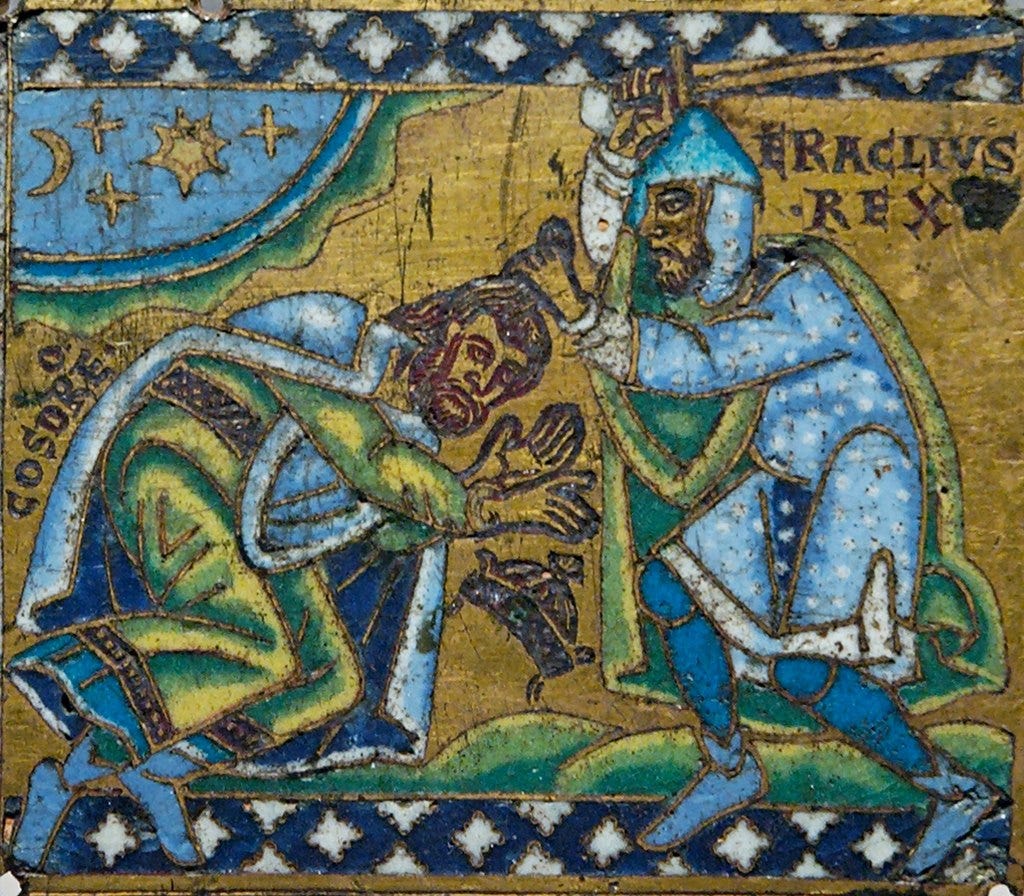
So, while one reading of Byzantine Christianity is constant imperial meddling in Church affairs, it may also be the case that the emperors served as a sort of “sin-eater” or scapegoat, taking on the moral burden of messy compromises. This might help further explain why Eastern Orthodoxy is famous for monastic zealots going to any lengths to condemn heresy or compromise on behalf of doctrinal purity, as in accounts of fanatical monks resisting iconoclasm, or attempted reunifications with Rome. In a civilization where Church and State are joined at the top, there can be a specialization of official roles underneath that unity. The emperors got their hands dirty, while the Church exhorted the ideal.4
This duality of political and religious authority goes back even further than the Byzantine Empire, of course. Arguably, the close partnership between Roman Emperors and Christian Church was merely a continuation of the incredibly ancient union of kings and priestly classes that we can trace all the way back to Sumeria and Egypt. Ancient near-eastern monarchs were God-kings who ruled on behalf of heaven, and were supposed to uphold a divinely-ordained cosmological order, as with Egyptian Pharaohs and Maat. In fact, if one looks at the core Christian story from a near-Eastern perspective, the notion of a Son of God and sacrificial atonement all become familiar tropes turned on their head. To a pagan versed in mythic stories of gods overthrowing their Fathers (Zeus and Chronos, etc), the story of a son who submits to the Father and does his will is a radical subversion. When the Book of Revelation talked about the whore of Babylon, a Greek-educated audience might well have remembered actual Babylonian temple-prostitution.
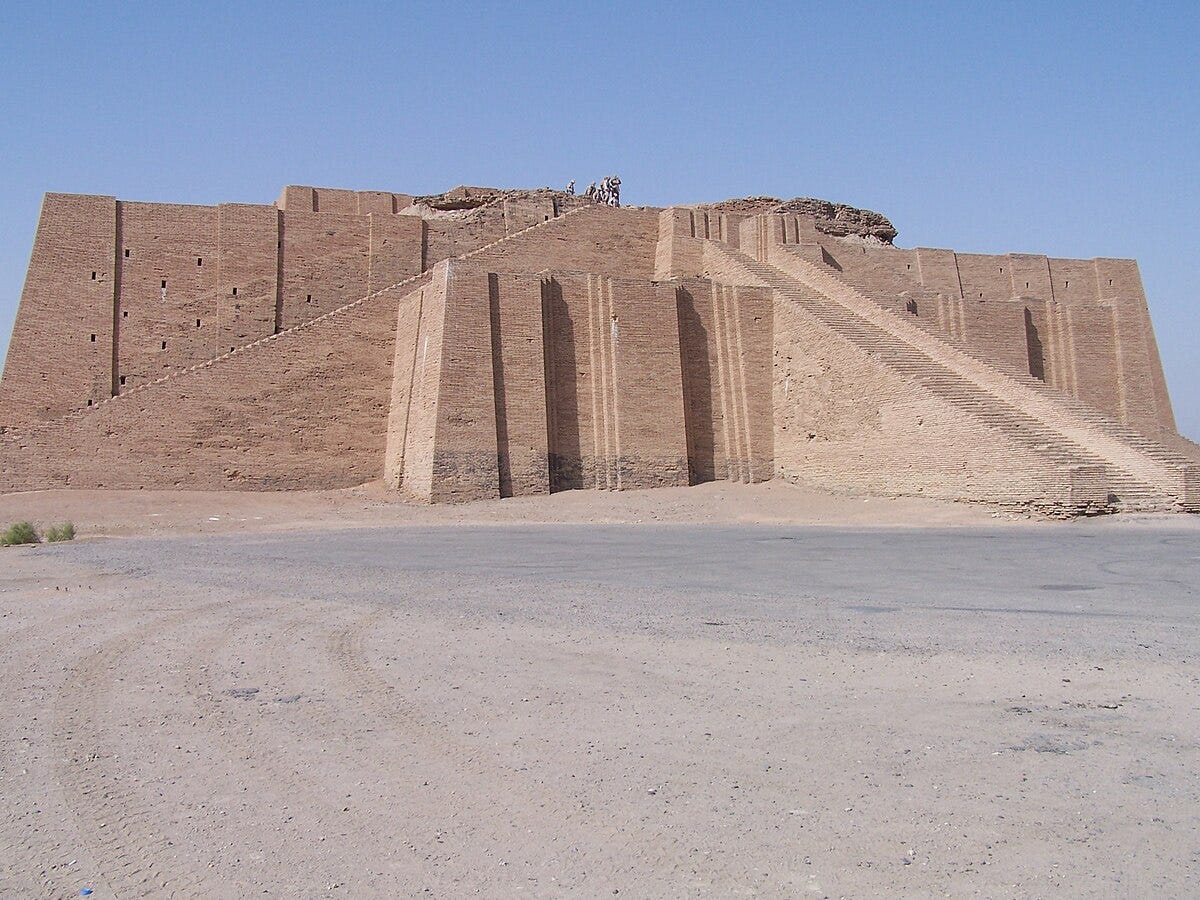
I will pause to acknowledge that, in my attempt to talk about the early modern world and separation of Church and State, I have just backtracked all the way to the time of Gilgamesh. Let me see if I can pay off the digression.
If we grant that ancient peoples would have taken an imperial/priestly duality as a common feature of a civilization, Constantine’s conversion to and championing of Christianity takes on a startling familiarity. And in fact, to Christians such as Eusebius of Caesarea, this rapidly became the story itself. Providence had taken over the Roman Empire and would continue to work out the Christian project of redeeming the world that had started with the Incarnation. Just as the Gospels took familiar religious myths and stood them on their head, so too would a united Church and Empire become a redeemed reflection of the divine cosmological order. The Sumerian, Egyptian, and Canaanite demonic inversions of the Biblical Divine Council had been redeemed and made good, as Christ’s reclamation of the world which started at Calvary, now reached the New Rome itself. In this telling of the story, Constantine’s “Equal to the Apostles” status didn’t represent the Church selling out to the Empire; but rather the baptism of the Empire.
For our purposes here, it’s the dual nature of this ancient tradition which is crucially important. In a single civilization with one imperial center, and one religious center, the two poles may compete and clash with each other, but they also depend upon each other. Every survey-level introduction to ancient near-eastern civilizations emphasizes how God-Kings had a duty to uphold the divine order and encourage subjects to make sacrifices and pay tithes to the priestly establishment, and how the priestly establishment in turn prayed for the king, advised and assisted him, and exhorted his subjects to obedience. Of course, if the king behaved badly, the priestly classes were moral arbiters positioned to remonstrate with him, and even if necessary declare him illegitimate. The priests could give moral sanction to rebellion, and could legitimate a new dynasty in the eyes of heaven.5 This civilizational topography had defined the ancient Near East, and now the Eastern Roman Empire. But it did not carry over to Western Europe.
Papal History Again, but from a Different Direction
Western Europe, unlike Byzantium or the ancient near-east, did not have dual poles of temporal and religious power. Instead, Europe suffered a political power vacuum with the fall of the Western Empire (Pope Leo met Attila outside the walls of Rome because no one else could). As petty Germanic kings carved whatever they could out of the corpse of the Western Roman Empire, the Papacy was left as the only pan-civilizational body with any institutional heft, organizational competence, or credibility. Popes such as Leo and Gregory the Great turned the Papacy into a bishopric much greater than a single diocese, and monastic clerics gave it an international bureaucracy not beholden to any city or nationality. During the early Middle Ages, kings and bishops from all over Western Europe sought out the Papacy for assistance, missionary talent, and legitimacy and prestige. Not until Charlemagne was any Western monarch remotely close in stature and importance to the Bishop of Rome. Constantinople was an ecclesiastical rival, but an increasingly distant one.
With the Holy Roman Empire after Charlemagne, we almost see the emergence of the same imperial/priestly duality as in Constantinople and Pharaonic Egypt, but the kings of Germany were never able to fully control Italy, and the Italian city-states eventually emerged as rival power centers both to Imperial German rule, and papal influence. The Gregorian Reform movement which cleaned house after the Rule of Harlots period, drew once again on the monastic resources of the Church, and created an institutional source of power not easily won over by any individual crown. On this new power base, and fresh off the initial success of the Crusades, the High Medieval Imperial Papacy asserted itself and reached the height of its moral authority and institutional power. Up through the 13th century or so, papal state-building and institutional skill outpaced Europe’s monarchs.

In hindsight, however, we should view the High Medieval Imperial Papacy as unsustainable, not because the Papacy couldn’t remain forever so exalted, but because the rest of Europe’s civilizational engines wouldn’t remain so weak. Throughout the 12th and 13th centuries, feudal Europe began to coalesce and slowly urbanize, and kings were quick to see that the Code of Justinian and Roman Law, initially studied in universities for the purposes of ecclesiastical canon law, could easily be used to help crowns increase tax revenues and assert royal justice. In the 14th and 15th centuries, Europe’s monarchies started catching up.
Note that for all the tumult and violence of the Rule of Harlots period in the 10th century, the German kings ultimately failed to consolidate control over Italy, whereas in the 14th century, the French monarchy was able to forcibly relocate the Papacy to Avignon for almost seventy years. Even before the Reformation, the outlines of crowns coopting and even usurping Church prerogatives were already emerging in Europe, as we also saw with the Spanish Inquisition.
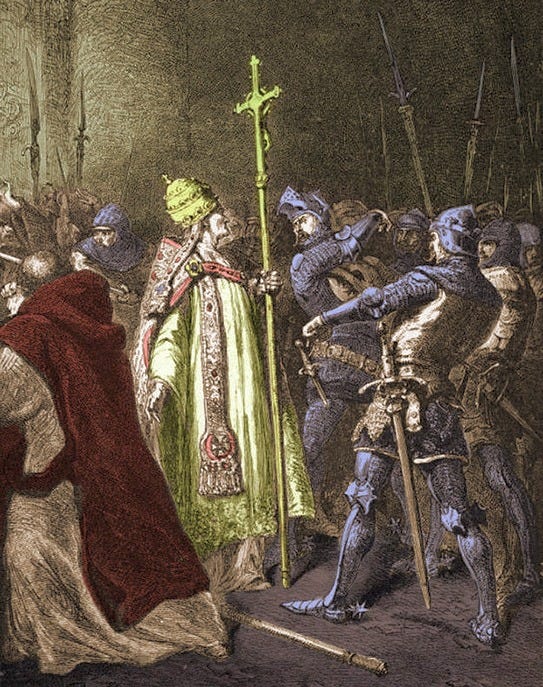
Stripping away the Protestant Reformation wouldn’t have changed the institutional drivers of Henry VIII’s Act of Supremacy claiming jurisdiction over Canterbury. Religious dispensations annulling royal marriages for the sake of producing an heir were hardly novelties during the Middle Ages (e.g., Eleanor of Aquitaine’s first marriage to Louis VII) and conflicts over royal jurisdiction in Church affairs were the whole point of the Investiture Controversy to begin with. The famous conflict between Henry II and Thomas Beckett was chiefly over the crown attempting to claim jurisdiction over Church courts. Even the Norman Conquest had been legitimated by the Pope sanctioning William the Conqueror’s invasion of England, on the condition of William appointing a new archbishop of Canterbury. If there had never been a wider Protestant Reformation, Henry VIII’s actions might simply have been compared with the similar Gallican movement in France.
For that matter, the kingdoms where Protestantism spread the least, were also the ones where royal governments had more control over the Church (France, Spain, Austria, etc). The French Wars of Religion weren’t a two-way fight between Catholics and Protestants, but a three-way struggle between radical Catholics, Huguenots Protestants, and a centrist Catholic Church/State hierarchy. The Huguenot Prince Henry of Navarre finally became king Henry IV only after a remarkably short-sighted radical monk assassinated Henry III for being too-accommodating to Protestantism. In order to become king, however, Henry of Navarre had to formally renounce Protestantism, famously quipping that, “Paris is worth a mass.”
We are now retracing territory already outlined in Parts I and II of this series, but hopefully through a new vantage point; forward from antiquity, rather than back from the Reformation and Enlightenment. First because of the Fall of the Western Roman Empire, and then because of the fragmented nature of Europe’s political kingdoms, Western Christendom never experienced the old duality of joint imperial/priestly power and authority. There was no Sargon, Ramses, or Constantine in Western Europe to both support and clash with the medieval Papacy. Instead, Europe developed many different power centers across the Eurasian peninsula, which all competed for influence and control over and within the institutional Church.
From a game-theoretic perspective, this equilibrium was far less stable than the old imperial duality. Ancient kings and priests sometimes clashed with each other, but they also needed each other, and as expressions of the same civilizational unity, both mattered to their subjects. But in a multipolar world, the Papacy became too important to let anyone else control, and either became closely allied with one kingdom or another, or became so beholden to temporal politics that it lost its moral credibility and ability to focus on its primary responsibilities. Recall that when Martin Luther finally mounted an existential challenge to papal authority, Leo X (a Medici family member placed in the role in no small part for family honor and interest) at first paid hardly any attention to the matter, and supposedly dismissed Luther as a drunken monk who’d sober up soon enough. Institutionally, the Papacy had already been wrenched away from its core mission.
In summary, then, rather than our received imagination of a pan-European Imperial Papacy presiding over a united Christendom, the Catholic Church had institutionally started to fragment even before the Reformation. Not “separation of Church and State,” but “separation of the Church into different states.”
The Conciliarist Path not Taken
Even before the Reformation, these problems were not lost on observant churchmen. Conciliarism arose during the 15th and 16th century, and played a key role in the Council of Constance (1414-1418), which helped end the Avignon Papacy and Western Schism. Haec Sancta Synodus, promulgated at Constance, suggested that even Popes themselves had to sometimes submit to the authority of Church Councils, though subsequent Church jurisprudence generally considered Haec Sancta as a one-time response, and not a binding precedent.
Consider a historical counterfactual wherein conciliarism gained ground throughout the early modern period, letting different factions within the Church negotiate through councils almost like a proto-Westphalian diplomatic forum (recall that ekklesia originally meant “assembly” in the ancient world). Such an arrangement might have given a stake to the different interests of Europe’s kingdoms without needing to go for do-or-die power grabs at the top of the religious hierarchy, and better reflected the fact that the Bishopric of Rome was no longer the most elite expression of power and influence in Europe, but one of many different political and cultural centers of influence. One could almost think of conciliarism as a failed attempt at creating a Magna Carta for the Catholic Church.
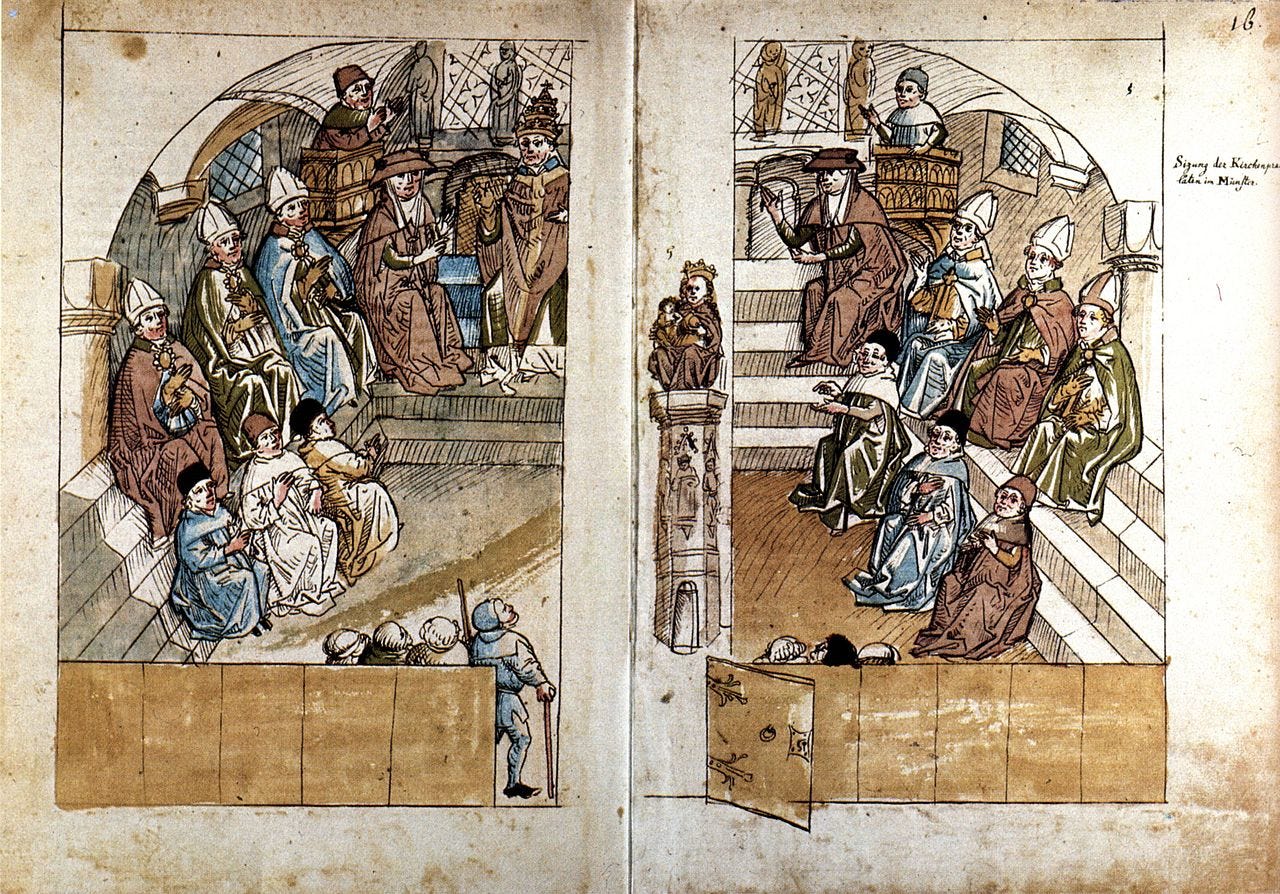
A more international, conciliar, and pluralistic Magisterium, however, would not have represented as much of a departure from the Middle Ages as it might seem. While medieval Europe was united under one Church and one notion of Christendom, one of the greatest factors distinguishing Western Europe from other pre-modern civilizational centers was its local particularity. Unlike in, say, Byzantium or the (in theory at least) Islamic World, Western Europe was politically fragmented, and only partially tied together by religion and an elite culture of Latin and classical learning. Civilization in Byzantium and Islam (or imperial China for that matter) much more heavily emphasized one political unity, while Western Europe jealously prized its individual kingdoms and cultures. One of the most brilliant achievements of Europe, which laid the groundwork for the later Great Divergence, was its ability to create proto-international non-state institutions (monastic and crusading orders, banking consortiums, guilds, etc) which cut across political and cultural barriers. Even within the Medieval Church, there was a great deal more variety in liturgy and local cults of saints and festivals than is commonly appreciated. An Early Modern Conciliarist Church might have represented a seeming outward departure from Medieval Christianity, while in substance being more continuous with it.
A more stable equilibrium with predictable rules and avenues for pursuing interests within the Church Magisterium might have also incentivized all parties (kings, bishops, cardinals, and popes) to work towards compromises and mutually-recognized norms, of the sort that can build up positive institutional rules and laws. In well-functioning systems and institutions, players have positive incentives to work within rules and norms, playing out the truth of Thomas More’s brilliant line in Man For All Seasons about laws being planted like trees which provide shelter against the devil when the winds blow. In a healthy system, justice and self-interest align.
As in Constantinople, a conciliarist arrangement might have enabled the Church to preserve more of its spiritual authority in its clear field of specialized leadership, leading to fewer Borgias and Medicis in St. Peters. But unlike in Constantinople, a conciliarist-led Church would have been less easily dominated by any one kingdom or imperial power, actually preserving more autonomy for the Papacy in the spiritual matters where Church leadership was the clearest and most important. This might have even evoked memories of the Early Church, when the Roman Empire’s large number of urban bishoprics resulted in rival patriarchates, and wherein Rome was more akin to a “first among equals.” It’s probably not an accident that conciliarism arose during the Renaissance, when antiquarianism was in vogue and the Early Church an intense focus of study by humanist scholars.
Conclusion
In other words, by the start of the 16th century, it’s possible to see how emerging divisions between political and religious power were already emerging in Europe, but also how they could have developed to a much greater extent than they did in practice. In fact, conciliarism almost acted as another reform-movement from within, mirroring the institution-building of Gregory the Great and the Gregorian Reformers previously. Crucially, conciliarism’s advocates often came from the universities (such as Jean Gerson at Paris), and came from the same general vein as well-regarded humanist thinkers such as Erasmus and Thomas More. Conciliarism faded in the face of the entrenched Church hierarchy, however, giving way instead to the infamous Renaissance Popes in the early 16th century.
Ironically, the event which most secured the renewed prestige and authority of the Papacy within Roman Catholic Christendom was in fact…the Protestant Reformation. The Protestant challenge to Rome couldn’t help but cause a massive rallying effect around the chair of St. Peter. The Council of Trent and Counter-Reformation made great strides in cleaning house and instituting needed moral and clerical reforms, while also stridently doubling-down on Rome’s doctrinal and spiritual authority, ultimately creating the Roman Catholic Church that the world knows today. Protestantism had become the new papal rival, just as Constantinople, the Holy Roman Empire, and Early Modern princedoms before it.
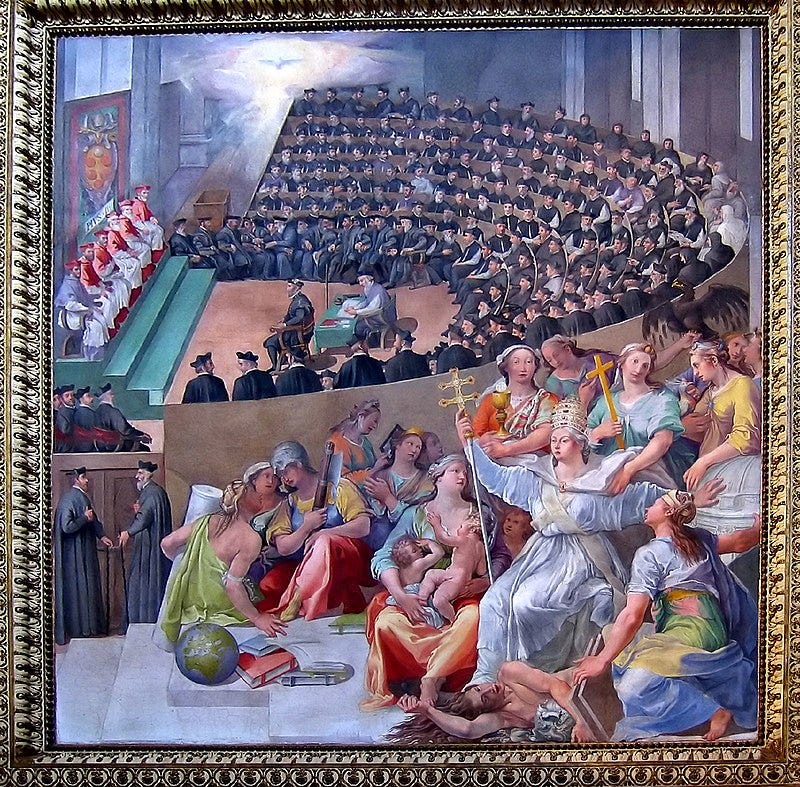
As the Roman Catholic Church pivoted to face the Protestant threat, it actually remade itself along lines surprisingly similar to that of Europe’s temporal powers, while also accommodating and legitimating those powers it was allied to. The 17th and 18th centuries were the ages of Absolutism and Divine Right Monarchy, featuring centralization of power and very strong hierarchical institutions (Ignatius of Loyola’s Jesuits were explicitly modeled on military lines, just as temporal kingdoms started building the first modern standing armies). To circle all the way back to our opening theme of historiographic narratives, the interests of historians connected to the Reformation, Enlightenment, and 19th Century Nationalism all accidentally conspired to to obscure the fact that the Tridentine Catholic Church had a surprising amount in common with the Absolutism of Louis XIV. Although both represented very old traditions, they were institutionally not quite as ancien as both they (and their enemies) claimed.
That will have to do it for this series. After working out some of these ideas and narrative arcs, I think there’s a lot more that could be said about conciliarism as a movement, and as a very interesting “road not taken” in the history of Christendom. This series has rather sprawled on me in the writing, but I have enjoyed it. I initially hoped to merely dash out a thousand words or so in the wake of the death of Pope Francis, and include a few memorable stories about past papal elections. Instead, mapping out all these themes has helped snap much of this history into sharper focus for me. That alone has made it a worthwhile endeavor. I hope readers may benefit similarly. Thank you.
Interesting parallels here to politics and activism in the age of social media, where individual actors have personal incentives to grandstand, at the expense of the institutions to which they nominally still belong.
In addition to Eusebius’ biography of Constantine, Anthony Kaldellis in The New Roman Empire (Pg. 91) discusses the placement and movement of Constantine’s tomb.
In addition to courting heresy, Heraclius was also one of the greatest generals in the entire history of Roman civilization, who engineered a near-miraculous comeback against the Sassanid Persian Empire, after the Persians had overrun Egypt, Syria, Palestine, and much of Asia Minor. The Byzantine-Persian wars of the 610s and 620s are criminally underrated.
Most any history of Byzantium will be chock-full of disputes between Emperors, heretics, the church hierarchy, and zealous monks and saints. But one interesting outcome of this messy relationship was a much greater sense that worldly life was full of what we might call “necessary evils.” So, for instance, Byzantine soldiers could be barred from communion for five years after having killed enemies even in an otherwise sanctioned war, and Byzantium never really developed a doctrine of religious war comparable to Latin Crusading, or Islamic Jihad. Likewise, Eastern Christianity was more likely to tolerate remarriage, while still assigning penance to couples, unlike the Western practice of granting dispensations which declared an act sinless. The upshot was a Western Latin tradition which, in trying to missionize and convert the world, tried to make legal rulings on all sorts of actions within the world, and an Eastern tradition which, precisely because it was more deeply enmeshed with the world, had to make allowances for what it saw as sin enduring in the world. I’m sure there are dedicated works that deal specifically with this question, but here at least, I’m drawing on books such as John Haldon’s Warfare, State And Society In The Byzantine World 565-1204, and Warren Treadgold’s A History of Byzantine State and Society.
These types of game-theory/cultural-evolution descriptions of religion are sometimes seen as cynical excuses handwaving away the sincerity of religious belief, but that is not my intention. In fact, the influence and authority of religion upon temporal power arguably is strongest when accompanied by sincere belief. Early on in C.S. Lewis’ Till We Have Faces, the old Priest of Ungit challenges the king of Glome over the necessity of sacrificing Psyche, and is clearly willing to die for his faith. In so doing, he wins the confrontation.



